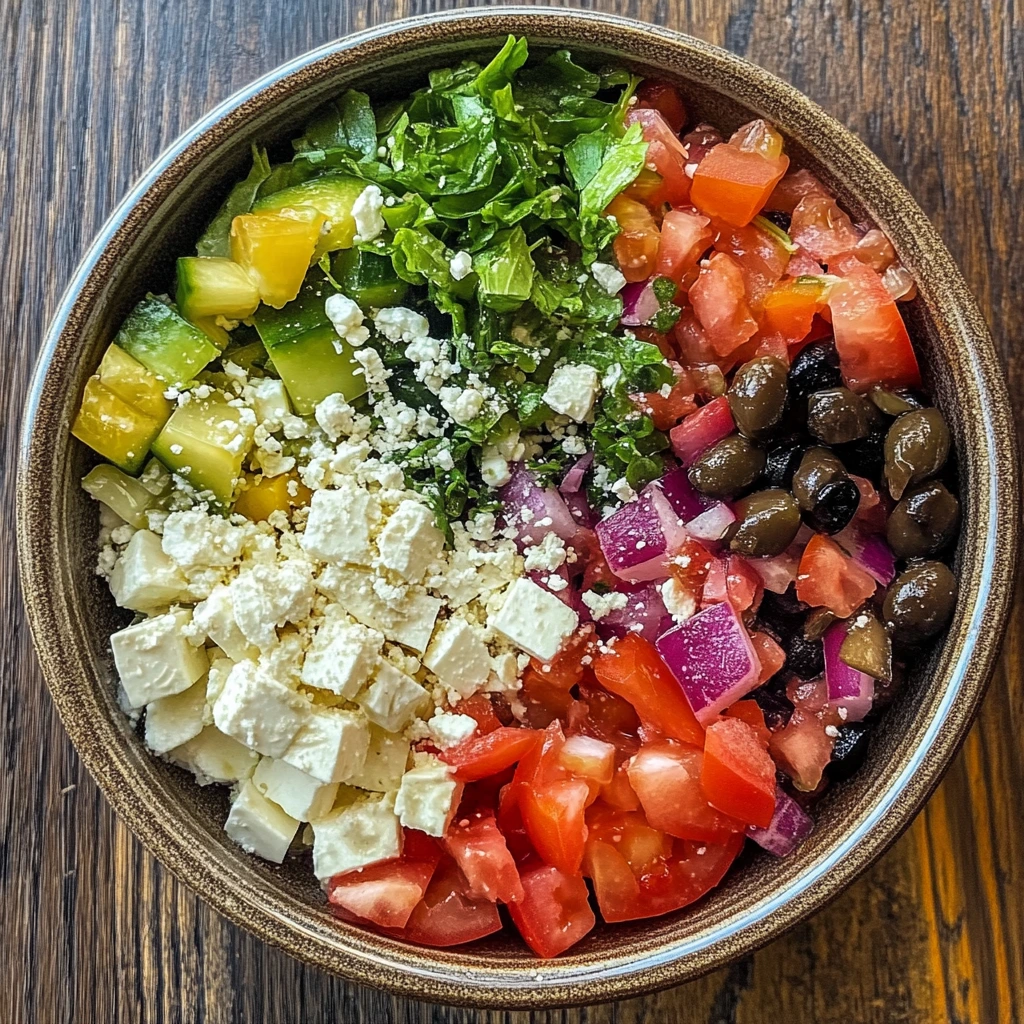Best Greek Salad Recipe
A traditional Greek salad (also known as “Horiatiki” salad) is a vibrant, refreshing dish that perfectly captures the essence of Mediterranean cuisine. With its combination of crisp vegetables, tangy feta cheese, and aromatic herbs dressed in olive oil, this classic recipe offers a perfect balance of flavors and textures. Whether served as a side dish or a light meal on its own, this authentic Greek salad will transport your taste buds straight to the sunny shores of Greece.
Table of Contents
Why You’ll Love
Greek salad stands out as one of the most beloved Mediterranean dishes for several compelling reasons. First and foremost is its simplicity – requiring just a handful of fresh ingredients, this salad delivers extraordinary flavor without complex preparation techniques. The beauty of Greek salad lies in its authenticity and adherence to traditional methods, letting the quality of each ingredient shine through.
Health-conscious eaters will appreciate that Greek salad is naturally nutrient-dense while remaining low in calories. Packed with vitamins, minerals, and heart-healthy fats from olive oil and feta cheese, it’s a nutritional powerhouse that doesn’t compromise on taste.
The vibrant color palette of the salad – with red tomatoes, green cucumbers and peppers, purple onions, and white feta – creates a visually stunning presentation that’s as appealing to the eye as it is to the palate. The contrasting textures, from the crispness of fresh vegetables to the creaminess of feta cheese, provide a satisfying eating experience.
Perhaps most importantly, Greek salad is incredibly versatile. It can be enjoyed as a light lunch, a refreshing side dish, or enhanced with protein for a more substantial meal. It’s perfect for meal prep, picnics, potlucks, and dinner parties alike, making it a true year-round favorite.

Preparation Time and Yield
Preparation Time: 15 minutes
Total Time: 15 minutes (plus optional 30 minutes marinating time)
Yield: 4 servings as a side dish, 2 servings as a main course
Difficulty Level: Easy – Perfect for beginners
Nutritional Information (Per Serving)
When divided into 4 servings, each portion of this Greek salad contains approximately:
- Calories: 220
- Total Fat: 18g
- Saturated Fat: 5g
- Cholesterol: 25mg
- Sodium: 480mg
- Total Carbohydrates: 10g
- Dietary Fiber: 3g
- Sugars: 6g
- Protein: 6g
- Vitamin A: 20% DV
- Vitamin C: 60% DV
- Calcium: 15% DV
- Iron: 6% DV
Ingredients

For an authentic Greek salad that serves 4 people, you’ll need:
- 4 medium ripe tomatoes (about 1 pound) – Look for firm tomatoes with rich color and a sweet aroma. Roma or vine-ripened tomatoes work wonderfully.
- 1 large English cucumber (or 2 smaller ones) – Choose cucumbers with firm, unblemished skin. English or Persian cucumbers have fewer seeds and a crisper texture.
- 1 green bell pepper – Select a pepper that feels heavy for its size with glossy, firm skin.
- 1 medium red onion – Look for firm onions with dry outer skin and no soft spots.
- 200g (7oz) high-quality Greek feta cheese – Authentic Greek feta is made from sheep’s milk or a combination of sheep and goat’s milk, and has a creamier texture and tangier flavor than cow’s milk versions.
- 16 Kalamata olives, pitted – These distinctive purple-black olives add a rich, fruity flavor to the salad.
- 2 teaspoons dried oregano (preferably Greek) – Greek oregano has a more robust flavor profile than Italian oregano.
- 1/4 cup extra virgin olive oil – Opt for high-quality Greek extra virgin olive oil for the most authentic flavor.
- 2 tablespoons red wine vinegar – Adds a pleasant acidity that balances the rich olive oil.
- 1 teaspoon sea salt – Coarse sea salt is traditional and adds texture.
- Freshly ground black pepper to taste
- Optional: 1-2 teaspoons capers – These add a briny, tangy element that complements the other flavors.
- Optional: 2 tablespoons fresh lemon juice – For a brighter, more citrusy dressing.
Step-by-Step Instructions
- Prepare the vegetables: Wash all vegetables thoroughly. Cut the tomatoes into medium-sized wedges or chunks (about 6-8 pieces per tomato). Slice the cucumber into 1/2-inch thick half-moons. Remove the seeds and core from the bell pepper and cut into 1-inch pieces. Thinly slice the red onion into half-rings.
- Combine the base ingredients: In a large salad bowl, combine the prepared tomatoes, cucumber, bell pepper, and red onion. Toss gently to mix the vegetables without bruising them.
- Add the olives: Scatter the Kalamata olives over the vegetables. If using capers, add them at this stage as well.
- Prepare the feta: Traditional Greek salad features a large slab of feta placed on top of the vegetables. Cut the feta into a rectangular block and place it atop the salad. Alternatively, you can crumble the feta and sprinkle it over the vegetables.
- Season the salad: Sprinkle the dried oregano over the entire salad, focusing especially on the feta. Season with sea salt and freshly ground black pepper.
- Dress the salad: Drizzle the extra virgin olive oil over the entire salad, followed by the red wine vinegar. If using lemon juice, add it now.
- Let it rest (optional but recommended): For the best flavor, allow the salad to rest for about 20-30 minutes at room temperature before serving. This gives the flavors time to meld together.
- Serve: Gently toss the salad at the table just before serving, ensuring the dressing coats all ingredients evenly.
Ingredient Background
Greek salad is deeply rooted in the agricultural traditions of Greece, where fresh, seasonal produce forms the cornerstone of the Mediterranean diet. Each ingredient in a traditional Greek salad has cultural significance and reflects the agricultural bounty of the region.
Tomatoes and Cucumbers: While not native to Greece, these vegetables have become essential components of Greek cuisine since their introduction from the Americas and India respectively. They thrive in the Mediterranean climate and are grown throughout Greece during summer months.
Feta Cheese: This iconic Greek cheese has been produced in Greece for thousands of years and is protected by EU legislation, meaning that authentic feta must come from specific regions of Greece and be made primarily from sheep’s milk, with up to 30% goat’s milk allowed. The cheese is brined, which gives it its characteristic tangy flavor and crumbly yet creamy texture.
Kalamata Olives: Named after the city of Kalamata in the southern Peloponnese, these distinctive dark purple olives are almond-shaped and have a rich, fruity flavor. They’re typically harvested when fully ripe and cured in a brine solution.
Greek Olive Oil: Olive cultivation in Greece dates back over 5,000 years, and the country remains one of the world’s leading producers of high-quality olive oil. Greek extra virgin olive oil typically has a robust, fruity flavor with a peppery finish, making it perfect for drizzling over salads.
Oregano: This herb grows wild throughout the Greek countryside and has been used in cooking since ancient times. Greek oregano (Origanum vulgare hirtum) is more pungent than other varieties and is often dried and used liberally in Greek cooking.
Technique Tips
Cutting Vegetables: For the most attractive presentation and best texture, cut vegetables into pieces of similar size. This ensures even distribution of flavors and makes the salad easier to eat.
Salting Technique: To prevent excess water from diluting your dressing, consider salting the tomatoes separately about 10 minutes before assembling the salad. This draws out excess moisture and intensifies their flavor. Simply drain the accumulated liquid before adding the tomatoes to the salad.
Temperature Matters: For optimal flavor, serve Greek salad at room temperature, not cold from the refrigerator. The olive oil can solidify when chilled, and cold temperatures dull the flavors of the vegetables.
The Feta Question: While many non-traditional versions crumble the feta, authentic Greek salad typically features a large slice placed on top of the vegetables. This preserves the integrity of the cheese and allows diners to control how much they incorporate into each bite.
Dressing Wisdom: Resist the urge to create a separate vinaigrette. Traditional Greek salad is dressed simply by adding olive oil, vinegar, and seasonings directly to the vegetables. The juice from the tomatoes mingles with these elements to create a light, natural dressing.
Alternative Presentation Ideas
While the classic bowl presentation of Greek salad is timeless, there are several creative ways to serve this versatile dish:
Individual Portions: Serve in mason jars or small individual bowls for a modern, portable presentation perfect for picnics or buffets.
Skewered Greek Salad: Thread cube-sized pieces of cucumber, tomato, bell pepper, and feta onto cocktail skewers for an elegant appetizer presentation. Drizzle with dressing and sprinkle with oregano.
Deconstructed Style: Arrange each component separately on a large platter in an artistic pattern, allowing guests to combine elements as they prefer.
Greek Salad Cups: Use endive leaves or small lettuce cups as edible vessels for a miniature version of the salad, perfect for cocktail parties.
Greek Salad Sandwich: Layer Greek salad ingredients inside a hollowed-out loaf of crusty bread, drizzle with dressing, and let it sit for an hour before slicing for a picnic-perfect option.
Watermelon Twist: For a summer variation, replace some or all of the tomatoes with cubed watermelon for a sweet-savory combination that pairs beautifully with feta.
Freezing and Storing
Fresh Storage: Greek salad is best enjoyed fresh, ideally the same day it’s prepared. However, if necessary, you can store it in an airtight container in the refrigerator for up to 24 hours. Keep the dressing separate if possible to prevent the vegetables from becoming soggy.
Component Storage: For make-ahead convenience, prepare all components separately and store them in individual containers in the refrigerator. The chopped vegetables can be stored for 1-2 days, and assembled just before serving.
Not Freezer-Friendly: Greek salad does not freeze well due to the high water content of the fresh vegetables, which would result in a mushy texture upon thawing. The feta cheese also doesn’t maintain its texture after freezing.
Leftover Ideas: If you have leftover Greek salad that’s beginning to wilt, consider repurposing it. Blend it into a cold soup, mix it into cooked pasta for a pasta salad, use it as a topping for grilled chicken or fish, or incorporate it into an omelet.
Serving Suggestions for Events
Casual Gatherings: Pair Greek salad with grilled souvlaki skewers, pita bread, and tzatziki for a complete Greek-themed meal that’s perfect for backyard barbecues.
Elegant Dinner Parties: Serve smaller portions of Greek salad as a refreshing first course before a main dish of Mediterranean-inspired fish or lamb.
Holiday Feasts: Include Greek salad as part of a larger mezze spread featuring hummus, dolmades, spanakopita, and other small plates for a festive Mediterranean feast.
Buffet Settings: Place Greek salad in a large, shallow bowl to showcase its colorful ingredients. Position it near complementary dishes like roasted lemon potatoes or Greek-style green beans.
Wine Pairings: Greek salad pairs beautifully with crisp white wines like Assyrtiko from Santorini, Sauvignon Blanc, or a light Pinot Grigio. For red wine lovers, a light-bodied Agiorgitiko or Pinot Noir works well.
Complete Meal: To transform Greek salad into a complete meal, add a protein such as grilled chicken, shrimp, or chickpeas, and serve with warm pita bread on the side.
Frequently Asked Questions (FAQs)
Q: Can I make Greek salad ahead of time?
A: While Greek salad is best enjoyed fresh, you can prepare the components up to a day ahead and store them separately. Combine and dress the salad just before serving for optimal texture and flavor.
Q: Is lettuce traditionally used in Greek salad?
A: No, authentic Greek salad (Horiatiki) does not contain lettuce or any leafy greens. In Greece, what Americans might call a “Greek salad” with lettuce is actually referred to as “maroulosalata” or a different type of salad altogether.
Q: Can I substitute ingredients if I can’t find authentic Greek products?
A: Yes, while authentic ingredients provide the most traditional flavor, substitutions can work well. If you can’t find Greek feta, look for any sheep’s milk feta. Regular black olives can replace Kalamata olives, though the flavor will be milder. Any good quality extra virgin olive oil can be used if Greek olive oil is unavailable.
Q: My feta cheese is very salty. Should I rinse it?
A: If your feta is too salty for your taste, you can briefly rinse it under cool water and pat it dry before adding it to the salad. However, keep in mind that the saltiness of the feta balances the other flavors in the dish, so adjust your added salt accordingly.
Q: How can I make this Greek salad more substantial as a main course?
A: To transform Greek salad into a heartier main dish, consider adding protein such as grilled chicken, shrimp, or canned tuna. For vegetarian options, add chickpeas, lentils, or quinoa. Serving with warm pita bread on the side also makes for a more filling meal.
Q: Can I use lemon juice instead of vinegar in the dressing?
A: Absolutely! Lemon juice is a wonderful alternative to red wine vinegar and provides a brighter, fresher acidity. Some recipes use a combination of both. Adjust quantities to your taste preference.
Conclusion
The beauty of Greek salad lies in its simplicity and the quality of its ingredients. This classic Mediterranean dish embodies the essence of Greek cuisine—fresh, straightforward, and bursting with natural flavors. By using the finest vegetables at the peak of ripeness, high-quality Greek feta, and the best olive oil you can afford, you’ll create a salad that’s far greater than the sum of its parts.
Whether served as a refreshing side dish on a hot summer day, a light lunch, or part of a larger Mediterranean feast, Greek salad offers a taste of sunshine and a glimpse into the healthy, flavorful traditions of Greek cooking. The combination of crisp vegetables, tangy feta, briny olives, and aromatic herbs dressed simply in olive oil creates a harmonious blend that has stood the test of time.
As with many traditional recipes, don’t be afraid to make this Greek salad your own by adjusting quantities to suit your taste preferences while respecting the authentic ingredients and preparation methods. By mastering this classic recipe, you’ll have a versatile, nutritious dish in your culinary repertoire that’s sure to delight family and friends on countless occasions.
Embrace the Mediterranean approach to eating with this authentic Greek salad—a reminder that when ingredients are fresh and of high quality, they need little embellishment to create something truly extraordinary.







